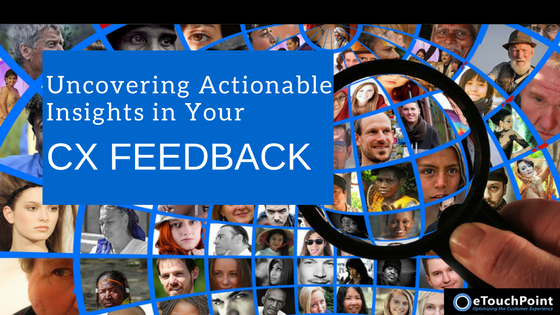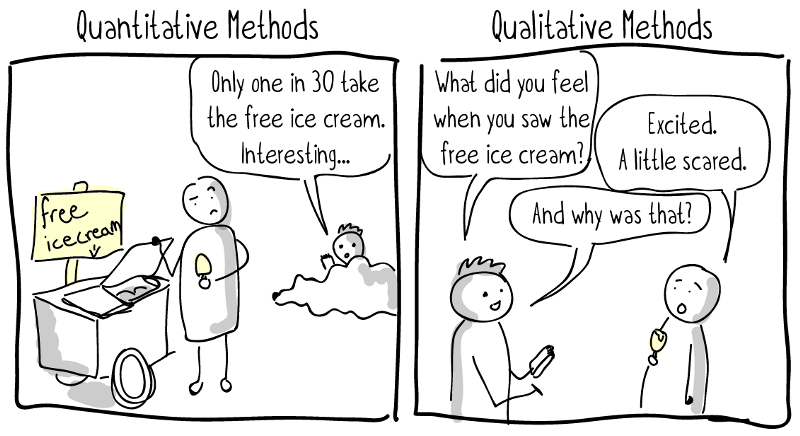Many companies today are actively engaged gathering customer feedback. However, there is a discrepancy in the type of feedback and the utilization. IDC estimates that 20.8% of the insight collected is structured/quantitative feedback. The remaining 79.2% is unstructured/qualitative feedback. What exactly does that mean?
Image Credit: Matt P Lavoie Journey Mapping with Quantitative & Qualitative Research
- Quantitative or structured feedback – numerical, statistical data such as promoter and detractor metrics.
- Qualitative or unstructured feedback – open-ended text feedback such as customer comments, social media and online reviews.
Often, customer experience (CX) professionals feel overwhelmed by the immense amount of qualitative customer feedback collected. They know key customer insights exist within the mountains of feedback, but aren’t sure how to evaluate the comments.
One way to access the powerful intelligence within qualitative feedback is to analyze the customer’s verbatim by focusing on the emotional message. Here’s how to unearth gems of wisdom hidden in your customers’ unstructured comments.
Shift Your Mindset to Focus on Customer Emotions
Customer expectations and their emotional response to interactions with your company dictate company perception in the marketplace. When reviewing customer feedback, you need to shift your mindset. You must focus on the perception and emotions instead of the numeric score. A great way to do this is to implement customer expectation analysis and evaluate each comment on these categories:
- Expectations met
- Expectations exceeded
- Expectations failed
To put this into practice, let’s review some customer survey responses:
“We continually return to your company for service, because the people are thorough, quick, efficient, they have good personalities.”
Expectations Met. Repeat customer due to consistent quality of service.
“The people who answer the telephone are rude, they don`t listen to you and they don`t help you. Everybody else is wonderful, the doctor and nurses, but the people who answer the phone give you a hard time every time.”
Expectations Failed. Though the interaction with the doctor and nurse were wonderful, the patient is left with a negative feeling because the staff isn’t helpful and friendly.
“The service I received was outstanding. My technician was punctual, flexible, responsible and very knowledgeable. I would highly recommend your company to any of my neighbors. Thank you.”
Expectations Exceeded. The customer praised the technician and has become a promoter of the business within the community.
“The technician did a very good job. My only comment is we had a wire hanging out on the road on Friday and my appointment wasn`t scheduled until Sunday. So I had a hazardous situation for a couple days and I was disappointed that your company couldn`t get to it quicker.”
Expectations Failed. Unfortunately, the perception of the company allowing a hazardous situation to continue for a couple of days overrides the positive sentiment about the technician.
“The person who answered the phone was very good. But, I had to hang on for so long that I`m very disappointed in that part of it. I think I hung on for I don`t know how long, but it was way too long.”
Expectations Failed. The representative resolved the issue without complaint, yet the hold time for the call was so extreme the customer is frustrated.
“Yes the technician that came to the house I thought was very hospitable and showed a lot of interest and was sorry with what happened to my services. He was outstanding.”
Expectations Exceeded. The customer is pleased that the technician provided service with empathy and kindness. This is a great example of how the experience with the technician overrode any negative emotions of the service issues.
How to Make Unstructured Feedback Actionable
With 80% of your customer feedback in unstructured feedback, it is important to pursue options and methods to utilize that information. Where structured data analytics uncovers the ‘what happened’ in your customer interactions, it is the resulting emotions found in the unstructured data that truly provide insight into the ‘why’. It is successfully reading the combination of the two types of feedback that provides a company with the complete picture of the customer experience.
Unstructured data analysis can be processed with text analytics programs to determine statistics such as frequently occurring words and phrases, but computer programs cannot replace humans for the ability to perceive the customer emotions and whether expectations were met, exceeded or failed. Human based transcription services allow companies to categorize large volumes quickly across several dimensions:
- Identify tone (positive, negative, mixed, neutral)
- Define sentiments
- Perceive emotion and expectation analysis
- Flag negative alerts
- Classify based on other custom actionable criteria
Customer Emotions Shape Perceptions of Your Company
By evaluating comments based on customer expectation analysis, you are focusing on the emotional response your company has created. This shift in how you view your customer’s feedback allows you to ‘read between the lines,’ and gain contextual insight into the comments.
Improving CX is a complex journey and as with all life journeys, it is the emotional response to milestones that sear in memories. When you meet or exceed customer expectations the emotional association with your company is positive.
If you aim to become a customer-centric leader, understanding how to create positive experiences with each interaction is essential. And unstructured feedback holds insights that can help you achieve this important goal.
Author: Chip James
Chip James is President of eTouchPoint, a pioneering customer experience (CX) technology provider that has provided solutions to Fortune 500 leaders for 15+ years. A CX industry veteran, Chip has been a leading CX advocate through speaking engagements and development of industry best practices. Prior to his work at eTouchPoint, Chip held leadership roles at Commercetel, Qualistics, and CGI. He completed his undergraduate degree at the University of Virginia and holds an MBA from Georgia State University.



